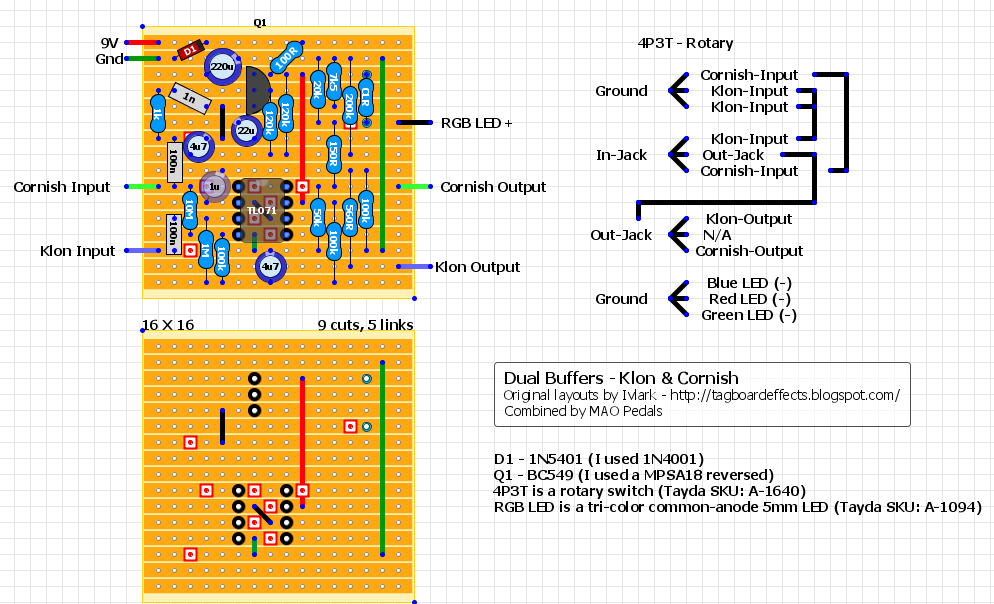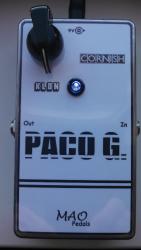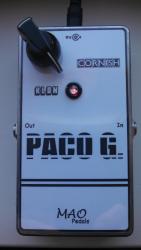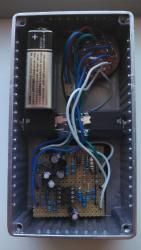Dual Buffers - Klon & Cornish
|
I wanted to build a buffer for a buddy and didn't know if he'd prefer the Klon or Cornish, I also couldn't see wasting an entire enclosure for such a small vero
 So I ended up combining both buffers onto a 16 x 16 vero. And since it really didn't make sense to use a stomp switch, I opted for a 3 position rotary switch and a RGB LED. So I ended up combining both buffers onto a 16 x 16 vero. And since it really didn't make sense to use a stomp switch, I opted for a 3 position rotary switch and a RGB LED.
I put this together on the fly so I apologize for the crude use and drawing of the 4P3T rotary, but it's pretty much how I originally drew it up on a piece of paper. Hope it makes sense. I wired the rotary so position 1 selects the Cornish buffer, the green LED and grounds the Klon input. Position 2 bypasses both buffers, selects the red LED and grounds the Klon input (the Cornish input floats). Position 3 selects the Klon buffer, the blue LED and grounds the Cornish input. (Let me know if there was a better way to wire up a 3 position switch.) I'll probably make another one for myself, so I thought I'd share. Hope someone else also finds it useful. Verified by me  I was able to salvage one of my earliest enclosures that I had butchered when drilling, and also found a use for a chicken head knob I've had for years 
   The gut shot shows the BC549 for Q1, I later swapped that out for a MPSA18 - which needs to be flipped 180 degrees. 
1978 Gibson Les Paul Standard, Cherry Sunburst
|
|
Just got this pedal back from a buddy who was testing it for me and I noticed the switching is a bit noisy, more of a crackling then a pop when switching to/from any position.
Annoying. I don't recall the switch sounding this way when I built it, but then again maybe I overlooked it. The Klon input is grounded in the bypass position, the Cornish input is not, I would think that switching from bypass to the Klon position would be quiet as it seems similar to normal 3PDT switching. Maybe a break-before-make rotary would have been better?
1978 Gibson Les Paul Standard, Cherry Sunburst
|
Re: Dual Buffers - Klon & Cornish
|
This post was updated on .
That 3 color LED is brilliant, haven't seen those before, only dual.
Gives me some nice ideas, so I'll have to get some of those! The switching noise you are experiencing, is as expected when you switch circuit while it is active. And the solution is very simple: Bypass/mute the pedal when switching. As far as I can tell, there should not be any reason to switch buffer in the middle of a song, or even during a gig... As you say, a break-before make might be better, but I guess there will be noise anyway. I have seen an article that deals with solutions to this, but I can not find it right now... As far as I can remember, the fix was to add a 1M resistor between every switch lug (on the input side) Meaning: a 1M between Klon input and bypassed input, and between bypassed input and Cornish Input. Try it and see if it helps... I actually have had the same noise issue today, when i built a A/B box that also has 4 different preamps on a rotary. I am not going to bother with it, since I choose the best matching preamp according to the amp I am using for the day, and never switch while the preamps are active. In other words: I set the one needed for the task of the day, and then forget about it... I guess this would be case as well when using buffers. Either you need it for your setup, or you don't... Tell your friend that this is not going to be an issue, since he is only switching when trying out which buffer he likes best. As soon as he has decided... He will probably not touch the pedal rotary switch again, except maybe during a soundcheck. Contrary to popular belief, a buffer is only needed for long cable runs when your amp is far away. Personally I try to avoid them as much as possible, since they have a tendency to reduce my picking dynamics and make the sound/amp less alive. I use a lot of vintage amps, and they are just like me: we hate buffers, because it makes us sound crap, compared to when not using them... While I'm already ranting about buffers, then I would like to mention something very obvious that very many people do not understand or think about: If you absolutely have to use a buffer: it belongs at the end of your pedal chain, not at the input, as most people do. That's were it has the desired effect: compensating for the long cable from your pedalboard to your amp) In my world, buffers are mainly needed as a part of a pedal circuit that requires a different input impedance then what your guitar pickup is putting out, and every time a pedal is active on your pedalboard, your signal is "buffered" (and very often "beyond buffered"), many people forget that fact... If I loose top end because of long cable runs, I use the simplest solution available: I turn up the treble on my amp. Works magic every time + it does not interfere with my dynamics.. ;-) Anyway... enough anti-buffer rant... I will try to find the fix. I know I've got it somewhere in my notes... as Arnold says: I'll be back! Cheers! |
|
Nice info,
I don't use a buffer myself so this is helpful. I never heard placing a buffer pedal at the end of your chain. I had thought the intent was to isolate your pickups from the rest of your chain, and in theory retaining the clarity and sparkle of your pickups through long cable runs. I agree since it is a set and forget, I'm not worried about the switching noise being an issue for him, just found it annoying. If he's concerned about it, I'll see what if anything can be done. I read a couple articles last night on it, but seems like there was conflicting info. If there was a known fix, I'd try it. On another note, I also read buffers could be useful if you daisy chain your power supply to multiple effects and noise appears when they are daisy-ed. This particular person actually had trouble with noise at a gig the other night 75% of the night. He had added a chorus/delay that night, running off an internal charge pump, to his normal Keely Compressor and PaisleyOD pedals all daisy chained on a 1.6A 9V power supply. He said all 4 pedals were noisy, which never happened before. I don't believe he could replicate the noise at home afterwards, but I thought if it's true a buffer may help with daisy chained effects, it would be worth a try in case he is plagued with noise again. Thanks again for your insight. Mike
1978 Gibson Les Paul Standard, Cherry Sunburst
|
«
Return to Buffers
|
1 view|%1 views
| Free forum by Nabble | Edit this page |

